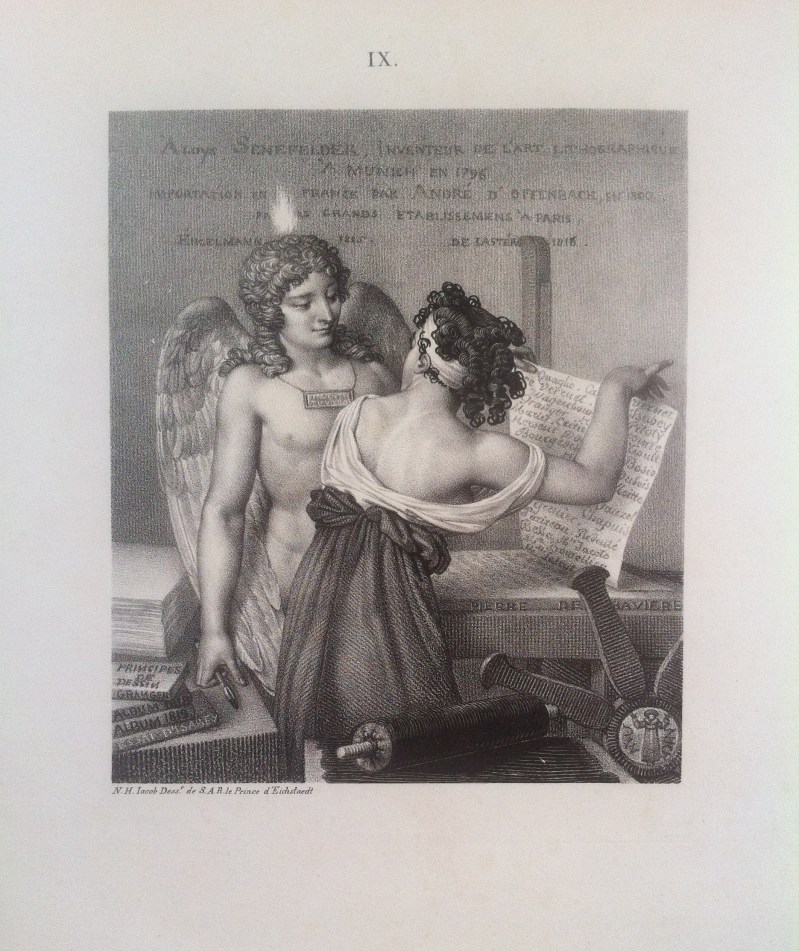Nicolas H. JACOB: Le Génie de la lithographie - 1819
SOLD
Lithograph, 235 x 178 mm. IFF 13.
Fine impression on wove paper. In very good condition. Five minor surface scratches in the subject, a very small scrape (2 mm) and a small repaired tear (10 mm) in the left margin. Exceptionally wide margins. Sheet: 410 x 270 mm.
Lithography was invented in 1796 by Aloys Senefelder in Munich. His manual Vollstandiges Lehrbuch der Steindruckerei [A Complete Course in Lithography] was published in 1818 in Munich and Vienna. It was translated into French and published in Paris in 1819. The French edition (L’Art de la lithographie) was followed by a collection of 20 lithographs published the very same year: Collection de plusieurs essais en dessins et gravures pour servir de Supplément à l’Instruction pratique de la Lithographie par Aloys Senefelder [Collection of several examples from both drawings and engravings as a Supplement to The practical Course in Lithography by Aloys Senefelder]. These 20 plates (some drawn by Senefelder himself) are examples of lithographs which reproduce drawings in pencil or ink, etchings, woodblocks and even sheet music.
Plate IX, usually titled Le Génie de la Lithographie [The Genius of Lithography], was drawn by Nicolas Henri Jacob, a draughtsman and lithographer, student of David. Its subject and its high quality distinguish it from the other plates. This is indeed a kind of manifesto for the nascent technique of lithography, which combines inscriptions with realistic and allegorical representations. A Genius with a pencil-holder in his right hand is standing in front of a lithographic press, next to a young lady who is lifting an impression from the lithographic stone. The majestic winged Genius, with the body of an ephebe, is smiling with kindness and maybe love at the young woman whose right shoulder has come uncovered in her effort. Plate XV in the Collection shows a reproduction of a text written in ink which could be a key for this etching: "Lithography just out of its cradle already gives noteworthy results. More and more often assisted by the Genius of Fine Arts, it will certainly provide surprising works, and will deserve a high rank among ingenious modern inventions" (our translation).
The inscription (top, middle) pays tribute to Aloys Senefelder, inventeur de l'art lithographique à Munich en 1796 and lists the main steps in the development of lithography in France: Importation en France par André d'Offenbach en 1800 - Premiers grands établissements à Paris: Engelmann en 1815, De Lasteyrie en 1816 [Imported to France by André d'Offenbach in 1800 - First establishments in Paris: Engelmann in 1815, De Lasteyrie in 1816]. Words inscribed on the edge of the lithographic stone: Pierre de Bavière, and on the wheel of the lithographic press: Munich, remind us of the German roots of this invention.
The interest of artists in lithography is highlighted by the names printed on the proof: Quaglio, Carle Vernet, Horace Vernet, Isabey, Wagenbauer, Piloty, Granger, Hippolyte Lecomte, Marlet, Chrétien, Bourgeois, Bosio, Dubois, Moitte, Vauzelle, Chapuis, Grenier, Redouté, Mlle Jacob etc. An inking roller lies on a table in the foreground and on the left there is a pile of blank sheets next to some books: Principes de dessin [A Course in Drawing] by Granger, two albums of lithographs printed in 1818 and 1819 and lithographic Essais by Jean-Baptiste Isabey.
The Genius is wearing a necklace with a pendant on which is written: INVENTE/TU VIVRAS. These are the last words of La Peinture, a poem comprising three cantos written by Antoine-Marin Lemierre (1733-1793) in 1769: « Artiste, suis mon vol au-dessus de la nue ;/Un feu pur dans l’éther jaillissant par éclats/ Trace en sillons de flamme, INVENTE, TU VIVRAS. » [Fly with me, artist, to the heavens;/where pure firesparks spring /and draw the blazing words: CREATE AND YOU'LL LIVE ON] (our translation). At the beginning of the third canto, an illustration engraved by Augustin de Saint-Aubin after Charles Nicolas Cochin shows a winged Genius, with a flame on his head, carrying away the Artist into the sky emblazoned with the motto INVENTE, TU VIVRAS. Nicolas Henri Jacob reused these words in his print in relation to the recent discovery of lithography.
References: De Géricault à Delacroix : Knecht et l'invention de la lithographie, 1800-1830, Frédéric Chappey, 2005; French lithography, The Restoration Salons 1817-1824, McAllister Johnson, 1977, p 59; E. Bocher, Les gravures françaises du XVIIIe siècle, 1879, fasc. V, Augustin de St Aubin, n°580.



